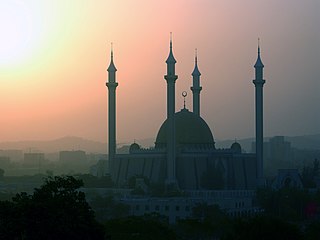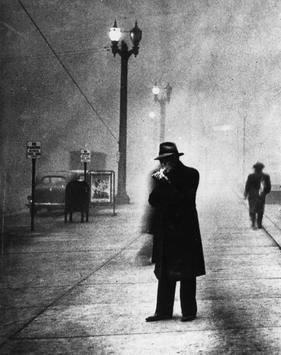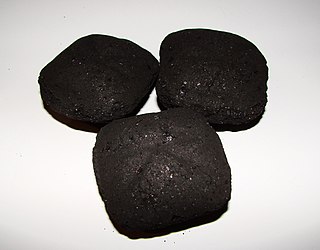Related Research Articles

Pollution is the introduction of contaminants into the natural environment that cause adverse change. Pollution can take the form of any substance or energy. Pollutants, the components of pollution, can be either foreign substances/energies or naturally occurring contaminants.

Smog, or smoke fog, is a type of intense air pollution. The word "smog" was coined in the early 20th century, and is a portmanteau of the words smoke and fog The following day the newspaper stated that "Dr. Des Voeux did a public service in coining a new word for the London fog."

The Great Smog of London, or Great Smog of 1952, was a severe air pollution event that affected London, England, in December 1952. A period of unusually cold weather, combined with an anticyclone and windless conditions, collected airborne pollutants—mostly arising from the use of coal—to form a thick layer of smog over the city. It lasted from Friday 5 December to Tuesday 9 December 1952, then dispersed quickly when the weather changed.

A smoke screen is smoke released to mask the movement or location of military units such as infantry, tanks, aircraft, or ships.

Haze is traditionally an atmospheric phenomenon in which dust, smoke, and other dry particulates suspended in air obscure visibility and the clarity of the sky. The World Meteorological Organization manual of codes includes a classification of particulates causing horizontal obscuration into categories of fog, ice fog, steam fog, mist, haze, smoke, volcanic ash, dust, sand, and snow. Sources for particles that cause haze include farming, traffic, industry, windy weather, volcanic activity and wildfires. Seen from afar and depending on the direction of view with respect to the Sun, haze may appear brownish or bluish, while mist tends to be bluish grey instead. Whereas haze often is considered a phenomenon occurring in dry air, mist formation is a phenomenon in saturated, humid air. However, haze particles may act as condensation nuclei that leads to the subsequent vapor condensation and formation of mist droplets; such forms of haze are known as "wet haze".

The Clean Air Act 1956 was an Act of the Parliament of the United Kingdom enacted principally in response to London's Great Smog of 1952. It was sponsored by the Ministry of Housing and Local Government in England and the Department of Health for Scotland, and was in effect until 1993.

The 1939 St. Louis smog was a severe smog episode that affected St. Louis, Missouri on November 28, 1939. Visibility was so limited that streetlights remained lit throughout the day and motorists needed their headlights to navigate city streets.

Air pollution is the contamination of air due to the presence of substances in the atmosphere that are harmful to the health of humans and other living beings, or cause damage to the climate or to materials. It is also the contamination of indoor or outdoor surrounding either by chemical activities, physical or biological agents that alters the natural features of the atmosphere. There are many different types of air pollutants, such as gases, particulates, and biological molecules. Air pollution can cause diseases, allergies, and even death to humans; it can also cause harm to other living organisms such as animals and crops, and may damage the natural environment or built environment. Air pollution can be caused by both human activities and natural phenomena.

Smokeless fuel is a type of solid fuel which either does not emit visible smoke or emits minimal amounts during combustion. These types of fuel find use where the use of fuels which produce smoke, such as coal and unseasoned or wet wood, is prohibited.

Environmental Protection UK is a UK environmental non-governmental organisation (NGO) working to improve the quality of the local environment - specialising in the subjects of air quality, noise management and land quality. It was formerly known as the National Society for Clean Air and Environmental Protection (NSCA), changing its name 2007, to reflect ongoing work in fields beyond air quality.
The 1948 Donora smog killed 20 people and caused respiratory problems for 6,000 of the 14,000 people living in Donora, Pennsylvania, a mill town on the Monongahela River 24 miles (39 km) southeast of Pittsburgh. The event is commemorated by the Donora Smog Museum.

Pea soup fog is a very thick and often yellowish, greenish or blackish fog caused by air pollution that contains soot particulates and the poisonous gas sulphur dioxide. This very thick smog occurs in cities and is derived from the smoke given off by the burning of soft coal for home heating and in industrial processes. Smog of this intensity is often lethal to vulnerable people such as the elderly, the very young (infants) and those with respiratory problems. The result of these phenomena was commonly known as a London particular or London fog; in a reversal of the idiom, "London particular" became the name for a thick pea and ham soup.

Air pollution in the United Kingdom has long been considered a significant health issue, and it causes numerous other environmental problems such as damage to buildings, forests, and crops. Many areas, including major cities like London, are found to be significantly and regularly above legal and recommended pollution levels. Air pollution in the UK is a major cause of diseases such as asthma, lung disease, stroke, cancer, and heart disease, and is estimated to cause forty thousand premature deaths each year, which is about 8.3% of deaths, while costing around £40 billion each year.

Air pollution in India is a serious environmental issue. Of the 30 most polluted cities in the world, 21 were in India in 2019. As per a study based on 2016 data, at least 140 million people in India breathe air that is 10 times or more over the WHO safe limit and 13 of the world's 20 cities with the highest annual levels of air pollution are in India. 51% of the pollution is caused by industrial pollution, 27% by vehicles, 17% by crop burning and 5% by other sources. Air pollution contributes to the premature deaths of 2 million Indians every year. Emissions come from vehicles and industry, whereas in rural areas, much of the pollution stems from biomass burning for cooking and keeping warm. In autumn and spring months, large scale crop residue burning in agriculture fields – a cheaper alternative to mechanical tilling – is a major source of smoke, smog and particulate pollution. India has a low per capita emissions of greenhouse gases but the country as a whole is the third largest greenhouse gas producer after China and the United States. A 2013 study on non-smokers has found that Indians have 30% weaker lung function than Europeans.

The 2013 Eastern China smog was a severe air pollution episode that affected East China, including all or parts of the municipalities of Shanghai and Tianjin, and the provinces of Hebei, Shandong, Jiangsu, Anhui, Henan, and Zhejiang, during December 2013. A lack of cold air flow, combined with slow-moving air masses carrying industrial emissions, collected airborne pollutants to form a thick layer of smog over the region. Levels of PM2.5 particulate matter averaged over 150 micrograms per cubic metre; in some areas, they were 300 to 500 micrograms per cubic metre.

United Kingdom environmental law concerns the protection of the environment in the United Kingdom. Environmental law is increasingly a European and an international issue, due to the cross border issues of air and water pollution, and man-made climate change.

Air pollution measurement is the process of collecting and measuring the components of air pollution, notably gases and particulates. The earliest devices used to measure pollution include rain gauges, Ringelmann charts for measuring smoke, and simple soot and dust collectors known as deposit gauges. Modern air pollution measurement is largely automated and carried out using many different devices and techniques. These range from simple absorbent test tubes known as diffusion tubes through to highly sophisticated chemical and physical sensors that give almost real-time pollution measurements, which are used to generate air quality indexes.

The air quality in Delhi, the capital territory of India, according to a WHO survey of 1,650 world cities, and a survey of 7,000 world cities by the US-based Health Effects Institute in August 2022, is the worst of any major city in the world. It also affects the districts around Delhi. Air pollution in India is estimated to kill about 2 million people every year; it is the fifth largest killer in India. India has the world's highest death rate from chronic respiratory diseases and asthma, according to the WHO. In Delhi, poor quality air irreversibly damages the lungs of 2.2 million or 50 percent of all children.

The 1966 New York City smog was a major air-pollution episode and environmental disaster, coinciding with that year's Thanksgiving holiday weekend. Smog covered the city and its surrounding area from November 23 to 26, filling the city's air with damaging levels of several toxic pollutants. It was the third major smog in New York City, following events of similar scale in 1953 and 1963.
References
- ↑ Heidorn, K. C. (December 1978). "A Chronology of important Events in the History of Air Pollution Meteorology to 1970". Bulletin of the American Meteorological Society. 59 (12): 1591. doi: 10.1175/1520-0477(1978)059<1589:ACOIEI>2.0.CO;2 . ISSN 1520-0477.
- 1 2 3 4 Bourke, Joanna (30 August 2016). "History on film: London is smothered by a dangerous smog". HistoryExtra. Retrieved 28 December 2020.
- 1 2 3 4 5 6 7 8 9 10 "BBC ON THIS DAY, 6, 1962: Choking fog spreads across Britain". BBC News . 6 December 2005. Retrieved 28 December 2020.
- 1 2 3 4 5 6 7 8 9 Prindle, Richard A. (1963). "Notes Made During the London Smog in December, 1962". Archives of Environmental Health. 7 (4): 493–496. doi:10.1080/00039896.1963.10663572. PMID 14054994 . Retrieved 28 December 2020.
- ↑ Department for Environment, Food and Rural Affairs (Defra) webmaster@defra gsi gov uk. "Smoke Control Areas (SCA)- Defra, UK". uk-air.defra.gov.uk. Retrieved 24 November 2023.